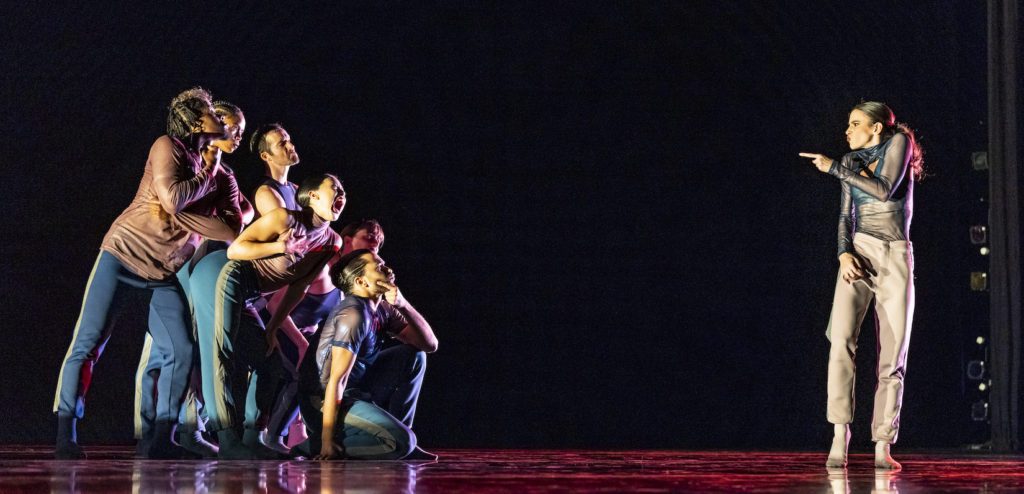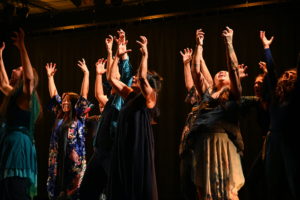Victoria: A winter season of content, and discontent - Vancouver Ballet Society
- Home
- City Reports 2020 - 2023
- Victoria: A winter season of content, and discontent

By Robin J. Miller
The good news first: Victoria’s 10-day Dance Days Festival in mid-January included some 70 free dance classes that were full to overflowing; the three short Rough Cuts shows of works in progress were well attended; and the two mainstage shows came close to selling out. The not-so-good, or maybe just confusing, news: the most memorable moments in this annual cornucopia presented by Dance Victoria came not in a mainstage show, where you might think they would, but from an untitled Rough Cuts piece by Visible Bodies Collective.
The self-described “council of BIPOC women” of all ages, most with little or no dance experience, seek first to speak to and support each other and second to communicate their stories through movement. Created in about five hours according to Collective founder Lindsay Delaronde (Kanienkehaka) — a mere blip in the time a professional dance company would need to produce a work — the piece carried an impact.

While the nine performers occasionally engaged with each other, it was clear from the start that their overarching goal was to express their individual experiences: sad, uplifting, difficult, hopeful. A loose structure of lines and circles kept the movement feeling planned rather than chaotic. Not great dance in the technical sense, but it was an honest attempt to express deeply held emotions, as the talkback made clear. One Collective member, for example, is a refugee from Iran, where women are not allowed to dance in public and it is illegal to be gay. As a gay woman, she said, it was a radical act for her to perform that day, and she was ecstatic.
Dance Victoria’s other winter offerings felt slightly pale in comparison. Mouth to Mouth by Luciana Freire D’Anunciação and Kelly McInnes, and Bearing Witness by Kemi Craig, the other two Rough Cuts shows, were clearly the result of months of thinking and planning and, in the case of Mouth to Mouth, many hours figuring out how to move inside what looked like oversized upside-down paper cups.
Mouth to Mouth began by deliberately pushing the audience’s patience. It took what seemed like hours before an arm started to emerge from one of the two triangular bodies. Slowly, slowly, D’Anunciação and McInnes evolved from their original shapes and merged together into some other kind of being. An interesting intellectual exercise for the two performers; less so for the audience.

In Bearing Witness, Craig worked with multimedia artist Justin Love to use coding electronics that respond to movement and sound. As the three live dancers — Craig, Lee Ingram, and Tania Betiku — moved, their bodies created cut-out shadows on the video images behind. Pretty enough, but which should we watch? And why?

At the MacPherson Playhouse, Vancouver’s Out Innerspace presented Bygones, which also dove into multimedia, but here a clear theme about the frightening changeability of our lives kept it giddily afloat for most of its 70 minutes. The work used old-fashioned stage magic — hidden strings that made a teacup jump, hidden hands that made dancers seem to fall from mid-air or slide across the stage — side-by-side with state-of-the-art lighting and video techniques to tremendous effect. Between them, lighting designer James Proudfoot and video lighting designer Eric Chad created angled walls that looked as solid as bricks and mortar, yet a hand or a head would emerge through them.
The six performers, too, were excellent, in bits and pieces of choreography created in a collaboration among company co-artistic directors Tiffany Tregarthen and David Raymond and their fellow dancers Elya Grant, David Harvey, Jade Chong, and Aiden Cass. Many of these bits, like Harvey being stalked by an umbrella, were gems. But the string of short vivid scenes gradually ran out of steam and, without a bolder narrative or stronger emotion to hold it together, sank into a sea of unresolved ideas.

By the time Los Angeles-based BODYTRAFFIC hit the Royal Theatre stage in February, I was ready for less dance theatre and more pure dance. And I got it.
The company of nine powerhouse contemporary dancers proved it could carry an extremely technical and physical show from end-to-end without any loss of energy or precision. The audience lapped up the choreography and music choices, which included A Million Voices by Mathew Neenan, set to the jazzy sounds of Peggy Lee; SNAP by Micaela Taylor, which sampled and then deconstructed James Brown hits like I Got the Feelin’; and The One To Stay With by Baye & Asa (New Yorkers Amadi “Baye” Washington and Sam “Asa” Pratt), which played hip hop rhythms against Russian waltzes and Romanian folk songs.

It was great, accessible dance, except that it was meant — and we needed it — to be more. According to introductions given from the stage by artistic director Tina Finkelman Berkett, the Neenan work was about freedom and the Taylor work about rejecting conformity and embracing our individuality, while Baye & Asa’s was a reflection on the opioid epidemic and the role the Sackler family played in it. In fact, there was not much change in mood or movement style from piece to piece (no sense of tragedy, for example, in the opioid piece). So, while the dancers were uniformly a joy to watch, even their brilliant, athletic technique became ever so slightly boring by the end.

